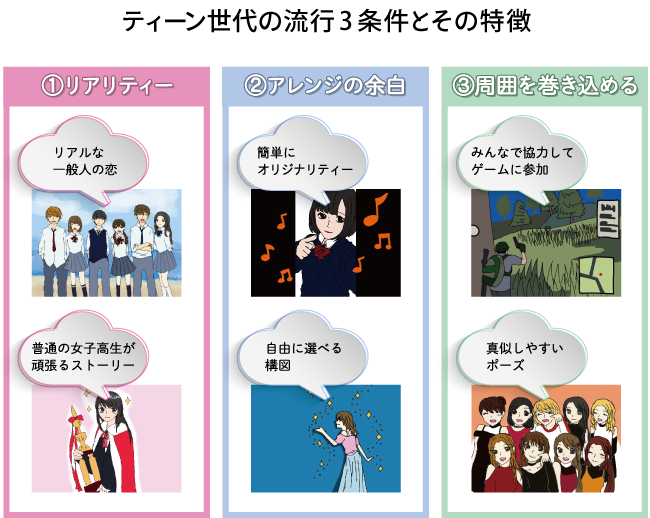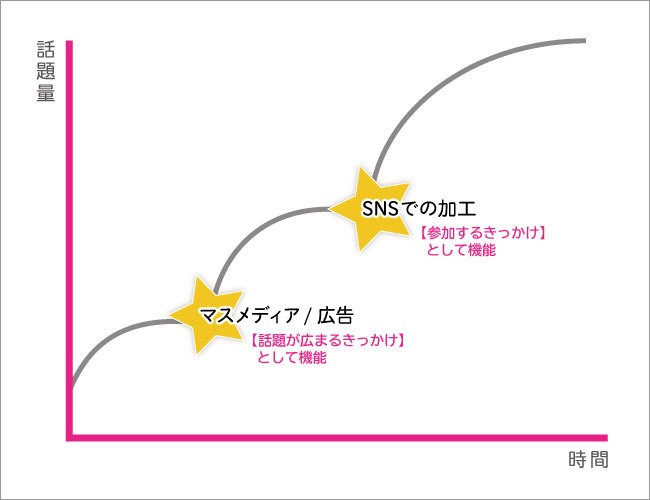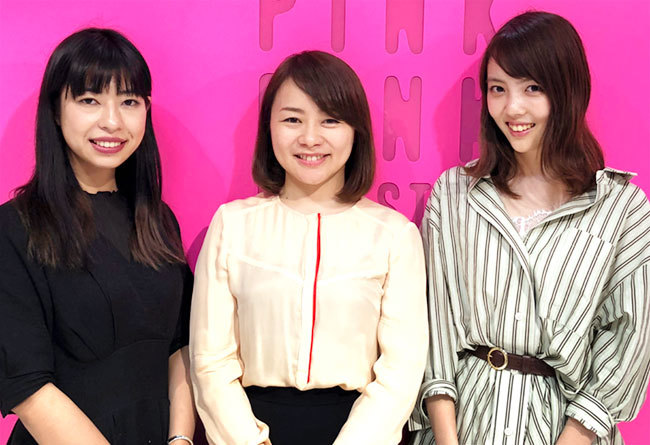Note: This website was automatically translated, so some terms or nuances may not be completely accurate.
Teens Obsessed with "Processgenic": A Thorough Analysis of Trends Among Teens Living in the SNS Era
Today's teens are smartphone natives and social media enthusiasts. What kinds of things move them, and how? This sixth installment of our series featuring teen influencers—"Teenfluencers"—thoroughly dissects how teen trends are born.
With the cooperation of Ryoko Inagaki from the GIRLS'TREND Research Institute—a research organization tracking high school and college girls operated by FURYU, a print sticker machine maker that continues to capture teens' hearts—we uncover the characteristics of trending content and how trends are born.
The results revealed the teen mindset: they are moved by the "process" – the background of the content and the journey it takes to become a hot topic.
What are the 3 conditions for teen trend content?

What exactly drives trends today?
After Ms. Inagaki unraveled the core elements of teen trends and the secrets behind their popularity, three key words emerged.
① Reality
The first keyword is "Reality." This refers to things that feel relatable, not manufactured by adults or corporations; things where you can see the process, not just the result; things you can empathize with and make your own.
On Abema TV, which garners strong teen support, content conveying this sense of reality is popular. Take the dating reality show "Today, I Fell in Love." This program features teens, mostly non-celebrities, engaging in genuine romance within the limited timeframe of a one-night, two-day stay.
Among the many dating programs on Abema TV, the reality elements—featuring ordinary people and depicting relatable dates like taking pre-wedding photos—are said to be key points that resonate with teens.
The popularity of high school girl beauty pageants and K-pop idols also hinges on this sense of reality. By publicly showing the audition process and making the journey to the final result visible, teens can easily connect with the authenticity.
② Room for Personalization
The second keyword is "room for personalization." Content that allows teens to add their own touches is a key condition for becoming popular.
Rather than simply enjoying content prepared by adults or companies, it's crucial that individuals can add a little personal touch and express their originality.
TikTok※1, cited in a pre-survey of teens as "the most popular thing around them right now," exemplifies this. Even using the same song, adding slight adjustments like facial expressions or movements creates an "original" video, making it easy to express individuality. This room for personalization means anyone can create a different video, making it instantly popular as enjoyable content.
Incidentally, TikTok's social media ads showcased this room for personalization by featuring a wide variety of original videos. This likely contributed to its trendiness.
※1 An app that lets users record videos of themselves playfully lip-syncing to music.
③ Engaging others
The final keyword is "engaging others." It's crucial that you can "easily teach" others and "enjoy together."
In a preliminary survey, 99% of teens recognized the game app "Knives Out" as a trending content. It's a battle royale game where about 100 players engage in gunfights on a deserted island. The app's defining feature is that it's "something you can do together." The game's mechanics, allowing you to play with people around you, are the reason for its popularity. In the pre-survey, over half reported learning about it through word of mouth from friends. Seeing friends play apparently led many to start playing themselves.
Similarly, last year's trends—like the "TT Pose"※2 made popular by K-pop group TWICE and TikTok videos—also spread largely because they were easy for everyone to do together and could be enjoyed by involving those around you.
※2 A pose where fingers form a T-shape and are placed under the eyes. It originates from the crying emoticon "TT".

Analyzing these trends reveals two defining characteristics of the current era.
First, the era of multiple SNS platforms has become the norm, creating a world where people are constantly connected and secrets can't be hidden. Second, we've shifted from the 1990s-2000s era where "charismatic figures" existed and teens found joy in imitating them, to an era without such figures, where each individual is expected to express their own personality.
These two major characteristics are thought to have changed the conditions for what becomes popular content. Teens want authentic stories that let them express their individuality and engage those around them. We're seeing a unique approach to popular content specific to the teen generation.
"Heard it on TV" is ancient history!? How teen trends are born
Before SNS, trends typically started with mass media like TV or advertising, gradually gaining traction as something new became a topic of conversation.
However, for teens who master social media, trends emerge through entirely different steps. In our conversation with Inagaki, two distinct patterns for how trends are born became apparent.
① Teen Influencers Spark Trends! The Discovery Step
<Discovery Step Concept Diagram>

Most recent trends among teens follow this "Discovery Step." The key element in this step is the presence of teen influencers.
In this pattern, information disseminated by "early adopters"—including teen influencers who obsessively track content within a specific niche—is discovered and amplified by multiple teen influencers. This rapidly increases the volume of discussion.
As the volume of discussion grows and it gains recognition as a trend, mass media picks it up as "what's hot right now." This acts as the trend's "official endorsement," propelling the content to spread nationwide.
Korean pop idols, which sparked a major boom among teens last year, followed the same steps. Korean pop enthusiasts discovered these idols, who then reached teen influencers. When these influencers spread the information, it became a hot topic among teens. Then, once they appeared on TV, the trend became nationwide, sparking a boom throughout Japan.
The fact that teens get their information from relatable teen influencers is very characteristic of the teen generation.
② The Key is "Room for Arrangement"! The Adaptive Step
<Processing-Type Step Concept Diagram>

The previously mentioned "Discovery Step" has the drawback of being difficult for companies to predict, as mass media coverage tends to follow the trend after it has already taken hold.
In contrast, the "Processing Step" pattern involves mass media or corporate releases serving as the starting point for a topic, creating the trend. In this pattern, the initial trigger for spreading the topic is information dissemination via mass media or advertising. After that, the key lies in "processing on SNS."
Information disseminated by media or advertising is processed and rearranged by teens, increasing the volume of discussion. When teens enjoyably rework corporate content in their own way and spread these creations among themselves, the content's discussion volume grows.
TikTok, the lip-sync app mentioned earlier, followed this same pattern. It gained popularity as teens added their own originality in various ways to songs used in ads or covered by famous talents.
For "photo spots," often used in corporate campaigns, whether they can follow this editing-based step is a crucial key.
The colorful wall at Tokyo Disneyland under construction, currently trending on Instagram, is one successful example. Despite not being explicitly promoted as a photo spot, teens line up to take pictures there, making it a hot topic.
Rather than photo spots with strictly defined compositions, teens seek spaces where they can freely add their own touches and express originality. This clearly shows the mindset of the teen generation, who don't simply turn their attention to things calculated and targeted by adults and corporations.
"Instagrammability" isn't the only yardstick for teens
We've examined content that moves teens and how it does so. What emerges is today's teen mindset: they value the underlying "process" more than a catchy appearance.
Regarding the three conditions for trending content, teens are less moved by things calculated and engineered by adults and corporations; instead, the "background" and "process" behind the content are crucial. Furthermore, in how trends emerge, the "process" of how the topic gained traction—such as the voices of trusted teen influencers or content edited by teens themselves—becomes a key trigger for trends.
It has become clear that being "process-genic"—having an appealing process—is the key to trends.

For teens, what's increasing in value is "things only available offline." The value of tangible items with a visible story—things you can't get online—is rising.
For birthday presents, items crafted with time and effort—like corkboards decorated with messages and photos, or surprise boxes (album-style surprise boxes)—are more popular than expensive gifts.
Word-of-mouth from real friends is also becoming more important than ever. Real friends are the most trusted source of information for teens. That's precisely why word-of-mouth from real friends plays a crucial role in verifying information learned on social media.
While teens are often associated with smartphones and social media, they don't get all their information solely from the internet or SNS.
Teens may seem swayed by superficial trends like "Instagrammability." Yet, they actually have their own unique standards. Understanding them and skillfully aligning with their perspectives is the key to capturing their hearts.
<What is the "GIRLS'TREND Research Institute"?>
A research and development institute within FURYU, the top player in the print sticker machine market*. It conducts various qualitative and quantitative surveys focusing on the sensibilities of high school and college-aged girls. Leveraging its cultivated marketing expertise targeting young women, it also publishes the free magazine "GIRLS'TREND," packed with timely information across diverse categories like fashion and beauty.
*According to FURYU research, summer 2016
http://www.furyu.jp/
<High School Girl Beauty Pageant>
What is the High School Girl Beauty Pageant?
With approximately 1.72 million high school girls nationwide, this contest—chosen by high school girls for high school girls—attracts over 300,000 entries (2017 figures) to crown the number one. Its innovative feature is allowing entries and votes via print sticker machines installed across Japan. The selection process is primarily driven by the public, enabling viewers to participate in the journey to crown the grand prize winner.
【Official Program】
https://www.youtube.com/channel/UCEeyy_fypedVHh1Lscu16CQ
【Twitter】
http://j.mp/JKmisscon_Tw
【Instagram】
https://www.instagram.com/jk_misscon/
<High School Male Beauty Pageant>
The "High School Male Student Mr. Contest" is
Japan's largest high school boy audition project to determine "Japan's Coolest High School Boy" from among male high school students nationwide. Entries are also possible using original stamps from the popular camera app SNOW.
Judging takes place on apps like SNOW and Twitter, which high school boys frequently use in their daily lives.
It has produced popular actors like Kyoji Honda, who appears in POPTEEN and stage plays and is climbing the ladder to stardom; Taito Nasu, who enjoys immense popularity among high school girls through appearances in shows like "Wolf Boy Won't Be Fooled"; and last year's Grand Prix winner, Fumiya Takahashi.
【Twitter】
https://twitter.com/DKmrcon
【Instagram】
https://www.instagram.com/dkmrcon.gram/
Was this article helpful?
Newsletter registration is here
We select and publish important news every day
For inquiries about this article
Back Numbers
Author

Anna Tatsuno
Dentsu Inc.
PR Solutions Division
Joined the company in 2017. PR Planner. Since joining, has been engaged in PR planning and creative development originating from PR. Belongs to Dentsu Inc. Gal Lab. As a researcher, is responsible for research and planning targeting women in their teens and twenties.



